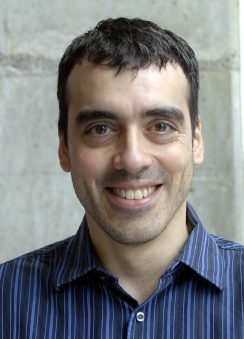It may have been the controversial “new math” that sparked young Pablo Parrilo’s interest in mathematics. In the 1960s and 70s, educators in Argentina, where Parrilo grew up, supported the idea of emphasizing structural principles rather than rote memorization in elementary math classes. Since then, educators throughout the world have moved away from the “new math” concept, but Parrilo was addicted from a young age. The theories made it seem more appealing than traditional arithmetic. “I do remember that it was fun,” he says.
Today, Parrilo is a Professor in the Department of Electrical Engineering and Computer Science, is on the faculty at LIDS, and is affiliated with the Operations Research Center. He came to MIT four years ago, after working as an assistant professor of Analysis and Control Systems at the Automatic Control Laboratory of the Swiss Federal Institute of Technology in Zurich. He received his Ph.D. in Control and Dynamical Systems (CDS) from the California Institute of Technology in 2000, and though he lived in Argentina for most of his life before then, has experienced very little trouble adjusting to the American way of life. “The U.S. is an easy place to get adapted to,” he says. “This country is well-prepared to receive an influx of people from different places.”
Pablo’s research at LIDS comprises mainly two areas: optimization techniques for engineering applications, and control and identification of complex physical systems. To put it more broadly, he studies systems in the real world, works to come up with mathematical models of them, and then he and other engineers can use these models to solve relevant engineering problems. Mathematical models are essentially formal descriptions of a system, and much of a researcher’s focus may be spent devising and improving these models, as well as designing algorithms for coming up with better representations.
While highly theoretical to most of us, for researchers like Pablo these models provide a tangible base from which to modify systems. These systems can be very concrete, such as a car engine, or more complex and less-defined, such as an economic or social network. “There are many cases where you have explicit mathematical models of a system,” Pablo explains, “and these models tell you, for example, how your car should run for optimal fuel consumption, or how to best stop the propagation of a disease.” However, he points out, describing a system using mathematics is not a simple task. While eminently useful for designers and system controllers, “these models are never exactly correct,” he notes. So, the question for researchers becomes, “how can you make accurate and reliable predictions, even though your models are only an approximation to reality?” Expanding on the car example, Parrilo points out that there are many events that could happen while driving a car, and it is difficult to take into account all of these through simulations. Imagine the possibilities: a sudden stop, airbag deployment, or a dramatic change in terrain, for example. However, with increasingly accurate optimization techniques and mathematical models, researchers and designers can get closer to accounting for all such eventualities, hopefully leading to safer, cheaper, more efficient systems.
Parrilo deeply appreciates what he calls (in Richard Feynman’s words) “the pleasure of finding things out.” While not unusual at LIDS, he points out that such passion is not prevalent everywhere. Indeed, he’s concerned about the younger generation’s lack of interest in research, something he cites when asked about American students’ declining math scores. “I think the notion that knowledge should not be pursued for its own value is a terribly destructive notion. We need to know things beyond today or tomorrow.” He also suspects many students decide too early to abandon a promising research career path in favor of earning more money. At MIT, however, he’s able to stimulate intellectual curiosity through his classes, which he enjoys a great deal. During the Spring 2008 semester, he taught “Algebraic Optimization and Semidefinite Programming,” a new course on advanced mathematical programming techniques. Parrilo says, “one of the things you always get out of teaching is a direct sense of accomplishment…by the end of the lecture the students, and you, have hopefully learned something.”
If he hadn’t become a professor and engineer, Parrilo says he may have followed his inclinations to have a career in the movies – behind the camera, as a director. He goes back to Argentina about once a year, where his sister is a veterinarian in Buenos Aires. Parrilo occasionally watches Argentinean football (soccer) during the World Cup when it comes around every four years, but is not a huge fan. “Some people claim that’s why they kicked me out of Argentina,” he laughs. Whatever the case, LIDS is very happy to have him. He is an accomplished, dedicated teacher and researcher, and has been recognized for that work in recent years. In 2005 he won the Donald P. Eckman Award from the American Automatic Control Council, and he has been a Finalist for the Tucker Prize of the Mathematical Programming Society for the years 2000-2003.




